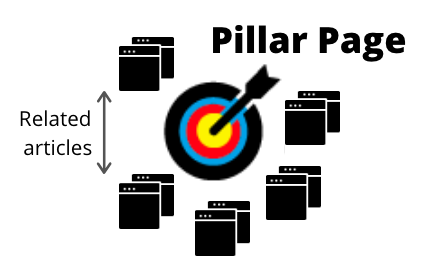Ever wonder what you could do to make your website produce twice the amount of clients it does right now? There are over 200 ranking factors you can use to increase the ranking of your website-so where do you begin?
The solution to producing long-term traffic is to play the long game and systematically address ranking factors that hold the most importance.
Three crucial elements to develop is your keyword strategy, content creation and building the strength of your backlink profile.
Establishing these foundational steps can set your site apart from your competition and earn you a top spot on the first page of search results.
Create Keyword Topic Clusters
You can’t publish content without knowing what keywords your site needs to rank for to drive targeted traffic. Finding the right keywords starts with simple brainstorming.
List the major services your company offers. Treat each category like an idea bucket and list the subtopics that will create a complete summary of your major topic.
For every topic and subtopic, type them into a keyword tool and generate as many ideas as possible. The goal is to find more keywords that describe your topic. Choose terms and phrases that have low competition and a decent amount of volume.
The most suitable search terms to target should be the one that is most relevant to what your clients are typing in a search. Take the keyword difficulty into consideration to make sure you are making a realistic decision on the keyword you decide to pursue.
At the same time, you’re also looking for ideas that will create depth to your keyword topic. Identify common search terms that should be included in your content to provide users with information that they often look for in association with your main keyword topic.
As you build your list, group your keyword into pools that represent separate pages in which you are able to write an entire post about in deeper detail.
This method of organizing your content is more notably recognized as a hub and spoke structure, or pillar page concept. Hubspot made this structure famous when they realized that they were publishing blog posts that had no relation to each other.
After structuring their blog with the pillar page format their rankings rose and they are now one of the most dominant blogs in the marketing niche today.

They used a pillar page as a hub to centralize ideas and create links to smaller articles that explained related concepts in greater detail. The pillar page linked out to the smaller articles and they all linked back to the pillar page.
Not only did this work to connect ideas with one common theme, but it created a structure that demonstrated depth in a keyword topic. The interlinking strategy uses anchor text links to optimize pages for a specific keyword.
The fact that the main pillar page is being linked to by so many related articles creates hierarchy and shows what pages are the most important within the context of a website.
Publish Content To Satisfy Search Intent
When you publish related content outlined by your pillar page you increase your ability to satisfy search intent. Rather than publishing random content, your ideas stay more connected to being able to explain the keyword topic in more detail and depth.
Search intent is one of the main criteria in determining the competitive placement of a website. Search engines are efficient and accurate at drawing meaning from content and reward the sites with that cover the potential intentions of a query.
To compete for top positions an emphasis is placed on authority, expertise and the ability to provide solutions to a range of common problems a user would naturally be inclined to search for when typing a keyword in a query.
The depth of content you create using topic clusters will help to demonstrate the expertise of your site. When your site has the ability to provide a solution to most of the commonly asked questions the probability of a user needing to search elsewhere is reduced.
If your website is the final destination for a user your site has effectively answered search intent.
Build The Authority Of Your Domain
The authority of your domain has always been a major factor in determining the ranking of your website. Build a high domain authority through link building and quality content for your site to improve its ability to outrank your competitors.
Search engines assess your backlink profile to determine who else in your field is endorsing your content. When you receive a link from another website it’s a sign of approval in your published content.
Publish Your Content Off-site
One of the most popular methods of link building is publishing an article on a popular blog site as a guest author. This method allows you a fair amount of control by being able to write your own content and publish it on a site within your industry.
The option for where your link is placed can sometimes be limited. Most often you will be granted an author bio in which you can link to your website. Many sites will also allow one or two links to your website from within the body of content.
An editorial link is considered more valuable so if the opportunity presents itself, make sure you capitalize by using brand-links, naked URL or long-tail anchor text links.
Reach Out To Sites Within Your Niche
Contact websites within your niche that have established domain authority. Find articles with content that complements the page in which you are trying to build authority.
Personalize each email to give yourself the best chance of acquiring the link. Include the URL of the article they’ve written in which you think you have the best chance of receiving a link. This way you can make the decision process less effort by doing the leg work yourself.
Once you find a post they’ve written in which a link would benefit both parties you can write an email something like this:
Hello [First name],
I just wanted to let you know that I admire the work you’re doing. I enjoyed your article “[insert URL]” and was most impressed with [insert what you liked about the article].
I noticed you linked out to this site [insert URL] and thought that you might also consider an article I recently published as it has freshly updated content and I think it would be a good fit for both of us. [Insert URL]
Either way, keep up the great work!
Sincerely,
[Your name]
One important aspect of outreach campaigns is to build relationships with your prospects. If they are actively blogging you may be able to form a mutually beneficial relationship that is worth more than one link.
Develop your site with the most important aspects of search engine optimization to give your site the best chances of performing in the search results. When you have mastered some of the largest factors that influence ranking you can focus on other aspects that provide competitive advantages in ranking for your keyword topic.
If you liked this article on organic traffic, check out these other Marketing.com.au articles:
- Clever Content Optimisation Tactics Necessary to Avoid Common SEO Mistakes
- Local SEO Guide for Growing Your Business
- How to Perform a Local SEO Audit All By Yourself
- 4 Powerful Mistakes to Avoid in Digital Marketing
- Become a Data Detective and Solve Your Own Marketing Problems
Christian Carere
Latest posts by Christian Carere (see all)
- How To Build Long-Term Traffic In 3 Major Steps - December 16, 2019








